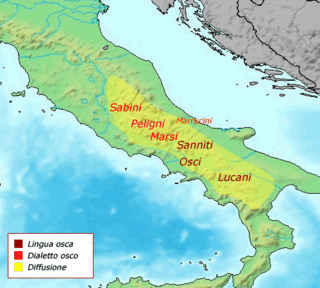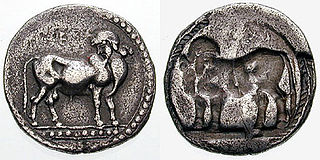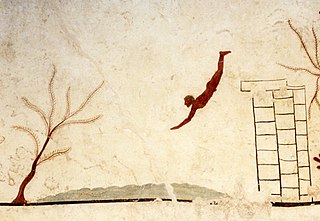Related Research Articles

In ancient Greek religion, Hera is the goddess of marriage, women and family, and the protector of women during childbirth. In Greek mythology, she is queen of the twelve Olympians and Mount Olympus, sister and wife of Zeus, and daughter of the Titans Cronus and Rhea. One of her defining characteristics in myth is her jealous and vengeful nature in dealing with any who offend her, especially Zeus' numerous adulterous lovers and illegitimate offspring.

Magna Graecia was the name given by the Romans to the Greek-speaking coastal areas of Southern Italy in the present-day Italian regions of Calabria, Apulia, Basilicata, Campania and Sicily; these regions were extensively populated by Greek settlers starting from the 8th century BC.

Paestum was a major ancient Greek city on the coast of the Tyrrhenian Sea in Magna Graecia. The ruins of Paestum are famous for their three ancient Greek temples in the Doric order dating from about 550 to 450 BC that are in an excellent state of preservation. The city walls and amphitheatre are largely intact, and the bottom of the walls of many other structures remain, as well as paved roads. The site is open to the public, and there is a modern national museum within it, which also contains the finds from the associated Greek site of Foce del Sele.

Velia was the Roman name of an ancient city on the coast of the Tyrrhenian Sea. It is located near the modern village of Novi Velia near Ascea in the Province of Salerno, Italy.

The Sele is a river in southwestern Italy. Originating from the Monti Picentini in Caposele, it flows through the region of Campania, in the provinces of Salerno and Avellino. Its mouth is in the Gulf of Salerno, on the Tyrrhenian Sea, at the borders between the municipalities of Eboli and Capaccio, in the beginning point of Cilentan Coast.

Triglyph is an architectural term for the vertically channeled tablets of the Doric frieze in classical architecture, so called because of the angular channels in them. The rectangular recessed spaces between the triglyphs on a Doric frieze are called metopes. The raised spaces between the channels themselves are called femur in Latin or meros in Greek. In the strict tradition of classical architecture, a set of guttae, the six triangular "pegs" below, always go with a triglyph above, and the pair of features are only found in entablatures of buildings using the Doric order. The absence of the pair effectively converts a building from being in the Doric order to being in the Tuscan order.

The Lucanians were an Italic tribe living in Lucania, in what is now southern Italy, who spoke an Oscan language, a member of the Italic languages. Today, the inhabitants of the Basilicata region are still called Lucani, and so is their dialect.

The Heraion of Argos is an ancient temple in Argos, Greece. It was part of the greatest sanctuary in the Argolid, dedicated to Hera, whose epithet "Argive Hera" appears in Homer's works. Hera herself claims to be the protector of Argos in Iliad IV, 50–52): "The three towns I love best are Argos, Sparta and Mycenae of the broad streets". The memory was preserved at Argos of an archaic, aniconic pillar representation of the Great Goddess. The site, which might mark the introduction of the cult of Hera in mainland Greece, lies northeast of Argos between the archaeological sites of Mycenae and Midea, two important Mycenaean cities. The traveller Pausanias, visiting the site in the 2nd century CE, referred to the area as Prosymna (Προσύμνη).

Laüs or Laus was an ancient city on the coast of the Tyrrhenian Sea. It was at the mouth of the Lao River, which formed the boundary between Lucania and Bruttium in ancient times and gave it its name.

South Italian is a designation for ancient Greek pottery fabricated in Magna Graecia largely during the 4th century BC. The fact that Greek Southern Italy produced its own red-figure pottery as early as the end of the 5th century BC was first established by Adolf Furtwaengler in 1893. Prior to that this pottery had been first designated as "Etruscan" and then as "Attic." Archaeological proof that this pottery was actually being produced in South Italy first came in 1973 when a workshop and kilns with misfirings and broken wares was first excavated at Metaponto, proving that the Amykos Painter was located there rather than in Athens.

Beit She'arim necropolis is an extensive necropolis of rock-cut tombs near the remains of the ancient Jewish town of Beit She'arim. In early modern times the site was the Palestinian village of Sheikh Bureik; it was depopulated in the 1920s as a result of the Sursock Purchases, and identified as Beit She'arim in 1936 by historical geographer Samuel Klein.

The Tomb of the Diver, now in the museum at Paestum, Italy, is a frescoed tomb of the 5th century BCE, famous for the mysterious subject matter of the ceiling fresco, a lone diver leaping into a pool of water. The context of the tomb is disputed: there has been scholarly debate about whether the tomb was built by people from the nearby Greek settlement of " Poseidonia", now Paestum, or by an ancient Italic tribe living in the surrounding countryside. The tomb was built with five large stone slabs, each with a fresco attributed to one of two artists. The four walls are decorated with scenes of a symposium which is uncommon for a funerary context. This diving figure is unique to this tomb, no other ancient Mediterranean artworks have imagery comparable to the diver.

Cilento, Vallo di Diano and Alburni National Park is an Italian national park in the Province of Salerno, in Campania in southern Italy. It includes much of the Cilento, the Vallo di Diano and the Monti Alburni. It was founded in 1991, and was formerly known as the Parco Nazionale del Cilento e Vallo di Diano.

The Gaudo Culture is an Eneolithic culture from Southern Italy, primarily in the region of Campania, active at the end of the 4th millennium BC, whose typesite necropolis is located near Paestum, not far from the mouth of the river Sele. Its name comes from the Spina-Gaudo necropolis.

The Kelsey Museum of Archaeology is a museum of archaeology located on the University of Michigan central campus in Ann Arbor, Michigan, in the United States. The museum is a unit of the University of Michigan's College of Literature, Science, and the Arts. It has a collection of more than 100,000 ancient and medieval artifacts from the civilizations of the Mediterranean and the Near East. In addition to displaying its permanent and special exhibitions, the museum sponsors research and fieldwork and conducts educational programs for the public and for schoolchildren. The museum also houses the University of Michigan Interdepartmental Program in Classical Art and Archaeology.

The Heraion at Foce del Sele is an archaeological site consisting of an Ancient Greek sanctuary complex dedicated to the goddess Hera in what was Magna Graecia. When built, the complex was located at the mouth of the Sele, approximately 8 km (5.0 mi) north of the Greek city of Poseidonia that was famous for its three standing Greek temples. Due to the deposition of alluvial sediment by the river, the site now is approximately 2.3 km (1.4 mi) from the modern coast.

The Pontecagnano National Archaeological Museum is a museum in Pontecagnano Faiano, in the province of Salerno, Italy that opened in 2007. Since December 2014, the museum has been managed by the Campania Museum Complex.

The Temple of Hera or Heraion is an archaic temple in Corfu, Greece, built around 610 BC in the ancient city of Korkyra, in what is known today as Palaiopolis, and lies within the ground of the Mon Repos estate. The sanctuary of Hera at Mon Repos is considered a major temple, and one of the earliest examples of archaic Greek architecture.

Paola Zancani Montuoro was an Italian classical scholar, archaeologist, educator and writer who specialized in ancient Greek art in Italy. After participating in the restoration of monuments around Pompei, in 1934 together with Umberto Zanotti Bianco, she embarked on excavation work in Foce del Sele which revealed the Sanctuary of Hera. From 1960, she investigated the ancient sites of Sybaris and Francavilla Marittima in Magna Graecia. She was an active member of the Accademia dei Lincei from 1956, where she served as a correspondent and editor.

The First Temple of Hera (Paestum)—also known as Temple of Hera I and the Basilica—is an archaic Doric order Greek temple in the ruins of the ancient city of Paestum, Italy. This Doric temple is considered one of the oldest Greek temples in Italy and is known for its distinctive architectural features. It was built around 550–525 BCE, within a century of the city's establishment by Greek colonists from Sybaris, who named the city Poseidonia.
References
- ↑ "Paestum, temples on the site of an important Greek city in Campania, Italy".
- ↑ https://lsa.umich.edu/kelsey/research/past-field-projects/paestum-poseidonia-italy.html
- ↑ https://helda.helsinki.fi/server/api/core/bitstreams/4dc75d67-7b14-40c3-ac44-d226ec109e57/content
- ↑ Alfano, Maria Rosaria; Baraldi, Anna Laura; Cantabene, Claudia (2023). "Eppur si muove: An evaluation of museum policy reform in Italy". Journal of Cultural Economics. 47: 97–131. doi: 10.1007/s10824-022-09447-6 . S2CID 247355296.
- ↑ "Paestum, 2017 da record: 22% di visitatori in più". 4 August 2017.
- ↑ https://helda.helsinki.fi/server/api/core/bitstreams/4dc75d67-7b14-40c3-ac44-d226ec109e57/content
- ↑ https://www.carc.ox.ac.uk/XDB/ASP/browse.asp?tableName=qryData&newwindow=&BrowseSession=99&companyPage=Contacts&newwindowsearchclosefrombrowse=false
- ↑ "Dionysus - My Favourite Planet People".
- ↑ "National Archaeological Museum of Paestum". 22 March 2018.
- ↑ https://www.researchgate.net/publication/346953810_Conservation_and_virtual_reconstruction_of_the_Lucanian_Paintings_from_the_National_Archaeological_Museum_of_Paestum_ITALY
- ↑ Amadori, Maria Letizia; Costantini, Ilaria; Madariaga Mota, Juan Manuel; Valentini, Laura; Ferrucci, Fabiano; Mengacci, Valeria; Camaiti, Mara (2021). "Calcium antimonate: A new discovery in colour palette of Paestum wall paintings". Microchemical Journal. 168: 106401. doi:10.1016/j.microc.2021.106401.
- ↑ https://www.researchgate.net/publication/325836009_Results_of_diagnostic_campaign_promoted_by_AIAr_in_the_deposits_of_the_Archaeological_Museum_of_Paestum/link/5b2861d3aca2727335b6fddf/download
- ↑ "Steinhardt Redux: Feds Seize Fresco Looted from Italian World Heritage Site, Destined for New York Billionaire". 18 November 2013.
- ↑ https://www.napolike.com/paestum-a-dip-in-the-blue-path-autism-friendly-archaeological-park-paestum
- ↑ Ferrari, Giorgia; Bosi, Giovanna; Ansaloni, Ivano; Sala, Luigi; Pederzoli, Aurora; Baraldi, Pietro; Mussi, Laura; Nannini, Matteo; Zannini, Paolo; Mazzanti, Marta Bandini (2018). "Images and colors from the tombs of Paestum: A multidisciplinary study of the pigments in the flora and fauna iconography". Journal of Archaeological Science: Reports. 20: 818–833. Bibcode:2018JArSR..20..818F. doi:10.1016/j.jasrep.2018.05.008. S2CID 194846036.
- ↑ https://commons.wikimedia.org/wiki/File:Metopa_Paestum_03.JPG#/media/File:Metopa_Paestum_03.JPG
- ↑ "Farewell scene, painted slab of Tomb 1 of the Necropolis in Spinazzo".
- ↑ Veneranda, Marco; Costantini, Ilaria; Prieto-Taboada, Nagore; Larrañaga, Aitor; Castro, Kepa; Arana, Gorka; Averna, Andrea; Rescigno, Carlo; Madariaga, Juan Manuel (2021). "Spectroscopic-assisted archaeometric studies to determine the production technology of the VI BC Zeus Enthroned statue (Paestum, Italy) and Pre-Roman technology transfer". Spectrochimica Acta Part A: Molecular and Biomolecular Spectroscopy. 249: 119294. Bibcode:2021AcSpA.24919294V. doi:10.1016/j.saa.2020.119294. PMID 33360059. S2CID 229692642.
- ↑ https://www.socgeol.it/files/download/pubblicazioni/Abstract%20Book/abstract_book_pisa_2017_doi.pdf [ vague ]
- ↑ http://www.archcalc.cnr.it/journal/resource.php?id=model:7
- ↑ Ugo Colombino, Annamaria Nese and Patrizia Riganti, "Eliciting public preferences for managing cultural heritage sites: Evidence from a case study on the temples of Paestum".